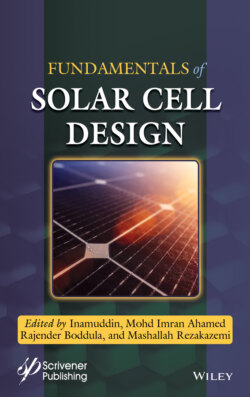Читать книгу Fundamentals of Solar Cell Design - Rajender Boddula - Страница 37
2.3.3 Multiple Energy Levels
ОглавлениеThe multiple energy levels are possible by designing the stacks of solar cells on top of each cell with a different energy band gap to increase the absorption of light. The stacked structure of PV cell utilizes maximum sunlight and produces maximum energy conversion efficiency. The each cell should have same lattice parameters to decrease the energy losses [43]. The energy band gap values are summarized for various materials with their maximum absorption wavelength in Table 2.2. The band gap energy vs. λmax curve for different photoactive materials is shown in Figure 2.5.
Table 2.2 Energy band gap of various absorber and metal nanoparticles.
| Material | Energy band gap (eV) at 300K | λmax (λ = hc/E = 1242/E) nm |
| Ge | 0.66 | 1,881 |
| Si | 1.11 | 1,118 |
| InP | 1.27 | 977 |
| CIGS | 1.42 | 874 |
| GaAs | 1.43 | 868 |
| CdTe | 1.44 | 862 |
| CZTS | 1.5 | 828 |
| CuO | 1.7 | 730 |
| CdSe | 1.74 | 714 |
| BiFeO3 | 2.09 | 594 |
| Fe2O3 | 2.1 | 591 |
| GaP | 2.25 | 552 |
| CdS | 2.25 | 552 |
| PbO | 2.9 | 428 |
| TiO2 | 3.2 | 388 |
| SrTiO3 | 3.2 | 388 |
| ZnO | 3.4 | 365 |
| SnO2 | 3.5 | 355 |
| ZnS | 3.6 | 345 |
| SiO2 | 8.9 | 140 |
